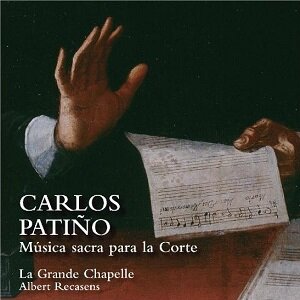
Carlos Patiño (1600-1675)
Música sacra para la Corte
La Grande Chapelle/Albert Recasens
rec. 2020, Igreja de Santo Quintino, Sobral de Monte Agraço, Portugal
Texts and translations included
Lauda LAU021 [68]
Albert Recasens is a specialist in Spanish music from the renaissance and baroque periods. With his ensemble La Grande Chapelle he has recorded more than twenty discs, often with little-known repertoire, sometimes by composers only specialists may have heard of. The present disc is an example of a project devoted to a composer, who is not unknown, but whose music is badly represented on disc. It is telling that eight of the twelve pieces in the programme appear on disc for the first time.
Carlos Patiño was born in 1600 in S María del Campo Rus, in the province Cuenca, and received his first musical training in the local Trinitarian convent. At the age of twelve he was a choirboy in Seville Cathedral, where he studied with the maestro de capilla, Alonso Lobo. Next he studied with the Portuguese Carmelite friar Francisco de Santiago, who brought him into contact with the future King João IV. In 1623 he was appointed maestro de capilla of the Seville Cathedral’s Sagrario Side Chapel. After a failed attempt to become maestro de capilla at the cathedral of Salamanca, he went to Madrid, where he became maestro de capilla of the Royal Monastery of La Encarnación. This allowed him to establish relations with circles at the royal court, and in 1634 he was appointed maestro de capilla of Philip IV’s Royal Chapel. In this position he succeeded Mateo Romero, who expressed his displeasure with his appointment, calling him a musician “of little finesse”.
Spanish church music was fairly conservative in the first half of the 17th century, but his predecessors, Philippe Rogier and Romero, had introduced elements of the Italian style. Rogier had turned to Andrea Gabrieli, and adopted the latter’s polychoral style. This was further developed by Romero, who introduced several features of the concertato style which came into existence around 1600. Patiño was clearly influenced by the style of his predecessors. The present disc is a survey of the different styles in his oeuvre.
The most conservative piece is the antiphon Salve Regina for four voices, which is written in strict imitative counterpoint. Libera me, Domine and Domine, quando veneris are responsories for the dead. The latter is entirely homophonic. nThe former includes quite some text expression, for instance staccat figures on the word “timeo” (I am afraid). The same is the case in Maria, mater Dei in which Patiño creates a musical contrast between “nunc vivens” (he yet lives) and “iam moriens” (he is already dying). The closing episode – “o clemens, o pia, o dulcis Virgo Maria” – is singled out. A feature of the concertato style is the declamatory treatment of the text, and such episodes can be noted in the Vesper psalm Lauda Ierusalem. Sapientia aedificavit is a motet for the Blessed Sacrament. It is a setting of words from the Old Testament book of Proverbs, and ends with the phrase “Eat, friends, drink and inebriate yourselves, my dear ones!” The lively rhythm is an eloquent illustration of these words. Another graphic depiction of the text appears in Beatus vir, on the words “fremet et tabescet” – he will gnash his teeth and be consumed.
The Magnificat usually followed the alternatim practice, but Patiño’s setting is through-composed; only the verse “Fecit potentiam” is left out, to be sung in plainchant. The Letanía a Nuestra Señora is for seven voices, and here the choirs alternate, but not in the sense that one choir sings the invocation (Mater Christi, mater inviolata etc) and the other the “ora pro nobis”. The latter words are always set in homophony. The sequence for Whitsun, Veni, Sancte Spiritus, is largely a dialogue between a solo soprano and the two choirs. In the opening episode the soloist sings the text, whereas the choirs answer in chord blocks “Veni”. In the closing episode the same happens, but then the choirs sing “Amen”.
In New Grove, Barton Hudson states that “Patiño was one of the finest musicians in Spain in the 17th century”, and this disc supports that positive assessment. It offers an interesting survey of the impressive qualities of Patiño as a composer of sacred music for the liturgy. His oeuvre also includes villancicos for the Holy Sacrament and for Christmas as well as secular tonos humanos. This disc makes curious about those parts of his oeuvre.
This recording also adds to our picture of sacred music in 17th-century Spain, as it documents the gradual development towards a baroque style. The performances underline this in the way the music is interpreted. The declamatory episodes come off to full extent, there is an excellent dialogue between the two choirs or solo voices and choir(s). The dynamic contrasts and the lively rhythms further underline the modern character of this repertoire. In most pieces the voices are supported by instruments: a cornett, two sackbuts, dulcian, violin, harp and organ.
The singing and playing of La Grande Chapelle is of the usual standard. It once again proves to be one of the best of its kind, and this disc is another jewel in the ensemble’s crown.
Johan van Veen
www.musica-dei-donum.org
twitter.com/johanvanveen
Help us financially by purchasing from



Contents
Lauda Ierusalem a 8
Maria mater Dei a 8
Ave Regina caelorum a 8
Magnificat a 8
Salve Regina a 4
Letania de Nuestra Señora a 7
Laudate Dominum a 12
Libera me, Domine a 8
Domine, quando veneris a 4
Beatus vir a 12
Sapientia aedificavit a 8
Veni, Sancte Spiritus a 9


















